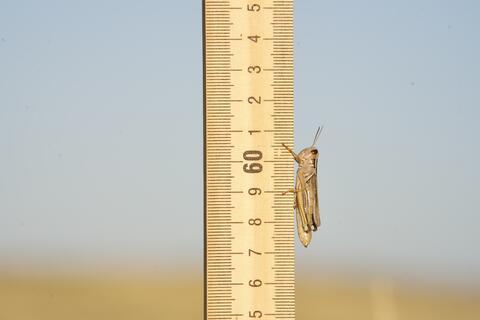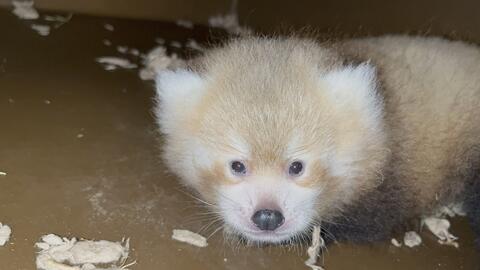News Archive
Filter By
- Abyssinian ground hornbill
- Addax
- Aldabra tortoise
- Allen's swamp monkey
- Alpaca
- American alligator
- American avocet
- American bison
- American flamingo
- American wigeon
- Andean bear
- Aquatic caecilian
- Arapaima
- Asian elephant
- Asian small-clawed otter
- Asian water dragon
- Australian snake-necked turtle
- Bald eagle
- Baltimore oriole
- Barred owl
- Bearded emperor tamarin
- Beaver
- Bennett's wallaby
- Binturong
- Black-and-white ruffed lemur
- Black-crowned night heron
- Black-footed ferret
- Black-tailed prairie dog
- Black-throated blue warbler
- Blue-billed curassow
- Blue crane
- Bobcat
- Brown pelican
- Bufflehead
- California sea lion
- Canvasback
- Cedar waxwing
- Channel catfish
- Cheetah
- Chicken
- Chinese alligator
- Chinese three-striped box turtle
- Clouded leopard
- Collared brown lemur
- Common raven
- Common yellowthroat
- Corals and sea anemones (anthozoa)
- Cow
- Crocodile monitor
- Cuban crocodile
- Dama gazelle
- Degu
- Dunlin
- Eastern corn snake
- Eastern indigo snake
- Eastern newt
- Eastern red-backed salamander
- Eastern screech-owl
- Eld's deer
- Electric eel
- Emperor newt
- Fennec fox
- Fishing cat
- Gaboon viper
- Geoffroy's marmoset
- Gharial
- Giant leaf-tailed gecko
- Giant panda
- Goat
- Golden-headed lion tamarin
- Golden lion tamarin
- Gray seal
- Gray wolf
- Green tree python
- Grevy's zebra
- Guam kingfisher (sihek)
- Guam rail (ko’ko’)
- Guinea pig
- Harbor seal
- Hartmann's mountain zebra
- Hawk-headed parrot
- Hellbender
- Home's hinge-back tortoise
- Hooded crane
- Iranian fat-tailed gecko
- Japanese giant salamander
- King vulture
- Komodo dragon
- Kori bustard
- Kunekune pig
- Land hermit crab
- Larger Malay mouse-deer
- Lemur leaf frog
- Lesser hedgehog tenrec
- Lesser kudu
- Lion
- Loggerhead shrike
- Long-tailed chinchilla
- Long-tailed salamander
- Maned wolf
- Meerkat
- Miniature donkey
- Naked mole-rat
- North American porcupine
- North American river otter
- Northern Luzon giant cloud rat
- Northern pine snake
- Northern pintail
- Northern red salamander
- Northern shoveler
- Northern snakehead fish
- Northern tree shrew
- North Island brown kiwi
- Norway rat
- Orangutan
- Orchard oriole
- Ossabaw Island hog
- Ostrich
- Ovenbird
- Pallas's cat
- Panamanian golden frog
- Patagonian mara
- Persian onager
- Philippine crocodile
- Prehensile-tailed porcupine
- Prevost's squirrel
- Przewalski's horse
- Pygmy slow loris
- Red-crowned crane
- Red-fronted lemur
- Red-rumped agouti
- Red-winged blackbird
- Red knot
- Red panda
- Red River hog
- Red ruffed lemur
- Red wolf
- Ring-tailed lemur
- Ruddy duck
- Schmidt's red-tailed monkey
- Scimitar-horned oryx
- Screaming hairy armadillo
- Semipalmated plover
- Semipalmated sandpiper
- Siamang
- Sitatunga
- Sloth bear
- Southern lesser galago
- Southern swamp sparrow
- Southern tamandua
- Spider tortoise
- Striped skunk
- Tanagers
- Tentacled snake
- Tiger
- Titi monkey
- Turkey
- Twig catfish
- Two-toed sloth
- Vietnamese mossy frog
- Virginia opossum
- Von der Decken's hornbill
- Western lowland gorilla
- White-cheeked gibbon
- White-faced saki
- White-naped crane
- White-nosed coati
- Whooping crane
Displaying 1 - 25 of 2401 articles.
Classroom Critters: How to Keep Ourselves and Our Reptile Friends Healthy ›
This blog from a Smithsonian intern highlights the joys of classroom pets, and outlines the steps necessary to keep students and animals safe.

Asian Elephant Program Media Resources ›
Find comprehensive resources for media on the Asian elephant program at the Smithsonian's National Zoo and Conservation Biology Institute.

Asian Elephant Is Pregnant at the Smithsonian’s National Zoo and Conservation Biology Institute ›
For the first time in nearly 25 years, animal care staff are preparing for the highly anticipated birth of an Asian elephant calf.

How Grasshoppers Beat the Heat ›
On hot days, humans rely on air conditioning, pools and fans to cool us down. Grasshoppers came up with their own clever trick for beating the heat: climbing.

ZooLights Returns Nov. 21 to Smithsonian’s National Zoo and Conservation Biology Institute ›
Washington, D.C.’s beloved family-friendly winter wonderland, ZooLights, returns to brighten the holiday season.

Giant Panda Qing Bao Gets a Checkup ›
Giant panda Qing Bao had a routine checkup Oct. 22. Veterinarians say she is in very good health!

Litter of Four Cheetah Cubs Born at Front Royal Campus, Smithsonian’s National Zoo and Conservation Biology Institute ›
Keepers at the Smithsonian's National Zoo and Conservation Biology Institute in Front Royal, Virginia are celebrating the births of a litter of cheetah cubs.

7 Spooktacular Animal Facts for Halloween ›
Read on for some chilling curiosities from the creatures of the Smithsonian’s National Zoo and Conservation Biology Institute.

Smithsonian's National Zoo Welcomes Two Weber's Sailfin Lizards ›
A new species just arrived at the Reptile Discovery Center… and visitors can meet a living “dragon” up close!

Meet the Orangutans Living at the Smithsonian’s National Zoo ›
Wondering which orangutan you’ll meet on your next visit? Get to know their names and personalities in this guide written by the Primates keeper team.

New Kits Born in Black-footed Ferret Cloning Research ›
The Smithsonian celebrates the birth of three litters of black-footed ferrets in the lineage of Antonia, a clone of a ferret who died more than 30 years ago.

Virtual Field Trips Bring the Smithsonian—and Its Animals—to Preschoolers Everywhere ›
Together with partners, educators at the Zoo and Smithsonian museums are delivering unique learning experiences to early childhood classrooms.

Meet the Red Panda Cub Born at Our Conservation Campus ›
In this Q&A, keeper Jessica Kordell shares the latest on our red panda cub’s developments.

#DCPandas: Happy 4th Birthday, Qing Bao! ›
Join us in wishing our “4-ever sweet” giant panda Qing Bao a happy 4th birthday!

Canada Lynx Have Arrived at the Smithsonian’s National Zoo ›
Say hello to Jasper, Rocky, and Yukon — three Canada lynx brothers you can now see at the Great Cats exhibit!

Smallest Herbivores Create the Biggest Impact for Grassland Forage ›
New Smithsonian research indicates prairie dogs and grasshoppers have some of the largest impacts on grassland nutrient cycles.

8 Fascinating Facts About the Cuban Crocodile, a Rare Caribbean Predator ›
They’re agile on land. Intelligent in behavior. And…they can gallop like a horse? Learn what makes Cuban crocodiles so extraordinary.
Meet the Meerkats: A Guide to the Smithsonian’s National Zoo’s Meerkat Family ›
Which meerkat is which? Small Mammal House keeper Ann Gutowski offers some clues on how you can tell the meerkats apart.

Two Ticketed Halloween Celebrations at Smithsonian’s National Zoo and Conservation Biology Institute ›
Boo at the Zoo and Night of the Living Zoo will return this fall at the Smithsonian’s National Zoo in Washington, D.C.

Smithsonian Bird Friendly® Celebrates 25 Years ›
What started as a way to protect migratory birds has grown into a global effort that safeguards tropical forests, conserves wildlife, and helps farmers build more resilient livelihoods.

#DCPandas: Preparing for Pseudopregnancy ›
Our giant pandas didn’t breed this year, but changes in Qing Bao’s behavior and hormones indicate she’s going through pseudopregnancy. Learn more in our panda team update!

Meet Our Roly-Poly and Prickly Lesser Tenrec Babies ›
They’re roly-poly, prickly and precious: meet our lesser tenrec babies! Get to know our growing tenrec family in this Q+A.
Study Reveals Carbon Markets Undervalue Shade-Grown Coffee Farms ›
A new Smithsonian study reveals that carbon-capture initiatives may be overlooking a critical tool in sustainable farming programs: mature trees.

Trio of Rare Maned Wolf Pups Are Thriving at the Smithsonian Zoo’s Conservation Campus ›
Behind the scenes, our South American canid puppies are growing fast. Get a glimpse into their daily lives in this update from the SCBI keeper team.

Scientists Use Climate Data to Map, Predict Amphibian Chytrid Disease ›
Thirteen years of climate data helps scientists understand the spread of a deadly amphibian disease and predict potential outbreaks.